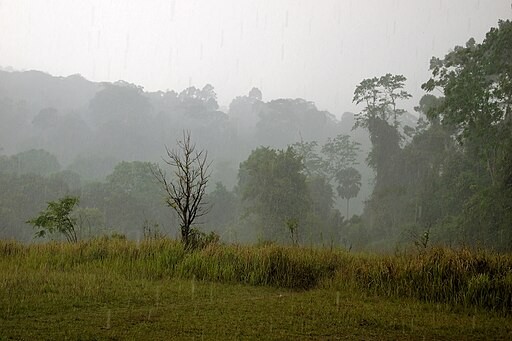Our planet is full of mysteries. The deeper we explore its formation and composition, the more surprised and spellbound we are. One remarkable story in the Earth's history is the Carnian pluvial event, a period during which our planet received continuous rain for 2 million years.

(Photo: Wikimedia Commons/ Vyacheslav Argenberg)
Two Million Years of Rain
In the 1970s and 1980s, geologists noticed unusual layers deposited in some ancient rocks assumed to be about 232 to 234 million years old. One team in the UK studied a layer of gray rock located within a well-known red stone in the area. Meanwhile, another team of researchers in the eastern Alps examined a layer of siliciclastic sedimentation formed within carbonate formations.
Both findings and other studies from various parts of the world revealed one thing. They had a similar conclusion that, at one point, our planet had quite a long dry spell before it began to rain. Given that the gray sandstone and siliciclastic sediment were deposited over a long, long time, it was theorized that an unusually wet period lasted one to two million years.
This period in the Earth's history happened during the Carnian period. It refers to the lowermost stage of the Upper Triassic Series, which lasted from 237 to 227 million years ago.
The unusual amount of rainfall appears to be due to a massive increase in humidity, likely caused by a large volcanic eruption of the Wrangellia Large Igneous Province. These volcanic eruptions, which might have peaked in the Carnian period, were so huge that they pumped vast amounts of greenhouse gases, such as carbon dioxide, into the atmosphere.
The Pangea supercontinent was already prone to monsoons at the time. These wind systems are caused by moisture-heavy air from the seas blown toward the land, where it cools and falls as heavy rains. As the seas are heated, they reach the temperature of hot soup. More moisture would have been above them, and more monsoons would have occurred, resulting in more heavy rainfall on land.
Triggering Extinction and Dominance
During the Carnian Pluvial Event, many plants and major terrestrial herbivores died and became extinct. This is because the humid, wet period was not great for life. A study also describes it as a time when volcanic eruptions generated acid rain and greenhouse gases, which triggered extinctions by shock warming, ocean anoxia, ocean acidification, and stripping of vegetation and soils on land.
While the event wiped out the majority of species, dinosaurs benefited from it. Since the discovery of this event, there has been growing evidence that the wet period may have been the trigger that enabled dinosaurs to diversify and dominate the land.
These giants expanded rapidly in terms of diversity, relative abundance, and regional distribution. This expansion started in South America and continued until the dinosaurs reached all continents.
Aside from the dinosaurs, other species of animals flourished during this fast-paced era, such as lizards, crocodiles, turtles, and mammals. These key clades have likely formed the modern fauna of terrestrial tetrapods.
RELATED ARTICLE: Floods, Heavy Rains Affect Photosynthesis as Often as Droughts in Many Sites
Check out more news and information on Rainfall in Science Times.














